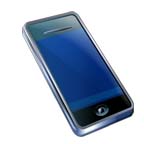 The iPhone may have been invented in the USA, but it’s the British who are on the cutting edge of using smartphone technology in citizen science. Most recently, the Zoological Society of London and the Bat Conservation Trust introduced iBats, a smartphone app. The app is a tool for bat surveys, which when used with an ultrasonic microphone, replaces the bat detector + recorder + GPS car-top set up covered here at State Wildlife Research News a few months ago.
The iPhone may have been invented in the USA, but it’s the British who are on the cutting edge of using smartphone technology in citizen science. Most recently, the Zoological Society of London and the Bat Conservation Trust introduced iBats, a smartphone app. The app is a tool for bat surveys, which when used with an ultrasonic microphone, replaces the bat detector + recorder + GPS car-top set up covered here at State Wildlife Research News a few months ago.
There is a blissfully clear explanation of the technology, the $249 ultrasonic microphone and the program in John Platt’s post on the Scientific American Extinction Countdown blog.
You can find the Indicator Bats Program (aka iBat) Web site here.
But the bat survey app is not the only game in town. The UK’s Mammals in Roads project, conducted by the Peoples Trust for Endangered Species has also gotten “smart,” with its own iPhone app that lets citizen scientists snap a photo of road kill and automatically record its location using the device’s internal GPS.
Read more about the project from our friends at Wildlife News. (Not related. Remember, they are in the UK.)
There are also many apps out there that serve as electronic field guides. Some of them include an information-collection aspect, which where things get a little complicated. Is it a field guide? Is it a citizen science tool? Take Networked Organisms and Habitats (NOAH) for example. It lets you identify plants and animals, and upload the location into a database. Read more about NOAH on its Web site. (This link goes to the news coverage page so you can read what the press has had to say.) We’ll have more on this project later.
Then there is LeafView, and LeafSnap, which appear to be the same project under different names. It IDs plants using face recognition technology. Early articles on the project, including this article on planetgreen.com mentioned a citizen science component, including an on-line herbarium. This New York Times article also mentions an app for identifying dolphins in Florida. In its LeafSnap incarnation, it is available to download now for iPhone and iPad. Think of the possibilities. The journal Science covered the story.
Find the contact info for botanists, ecologists and tree experts who want to volunteer with the program on LeafSnap’s About page.
Where does this leave wildlife biologists that would like to empower citizen scientists with smartphone technology? This BBC article tries to sum it all up, but it zigs and zags and I’ve got to wonder if the article just tries to cover too much territory.
The answer seems to be this: the technology is available. What is needed is funding, time, and the willingness to go large with an app that requires a $250 microphone.

Thanks for sharing this. Not only are there plenty of apps, there's no shortage of citizen science projects to get involved in. Hundreds are included in a searchable database at http://www.scienceforcitizens.net
Thanks again.